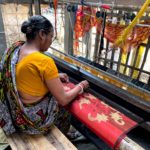In the heart of jamdani country is a powerloom facility.
About 30 looms clatter in a large space and produce the equivalent of what 250 weavers will take a month to create.
Handloom weavers hate power looms because input from out of work. They talk about it as if it were a whirlpool, pulling you under, into the dark side.
Once you work in a power loom facility, you can never come back to handlooms because you will lose the skills in your hands, legs and eyes, says one weaver.
The work is easy, says another, so the less skilled weavers simply stand and check for errors. They check if the yarn breaks.
It isn’t even real yarn, says a third. In order to withstand the pressure of the power looms, the use and that is like plastic. It doesn’t break.
There is one and only one reason why power looms are making inroads into the sector: economics.
Power loom sarees sell for a few hundred rupees while handloom sarees sell for 10 times that amount.
Smart weavers are adjusting to its presence. They market their handmade sarees as luxury goods. They talk about sustainability and the fact that they use natural dyes. They say that naturally dyed sarees are good for health; good for the planet.
Like it or know that, the powerloom is here to stay and all of us who love handlooms have to adapt to its presence.
So how can you tell an authentic handwoven jamdani? Look at the borders. Look at the spacing of the motifs. Do they look machine-made? Too evenly spaced? Too uniform? With no soul? Then it is made by a power loom.
The biggest indicator is the price. If you have elaborate motifs in a saree that seems very cheap, you can bet that it is machine-made.
Cheap does not always mean good. And cheap definitely does not mean handwoven.




